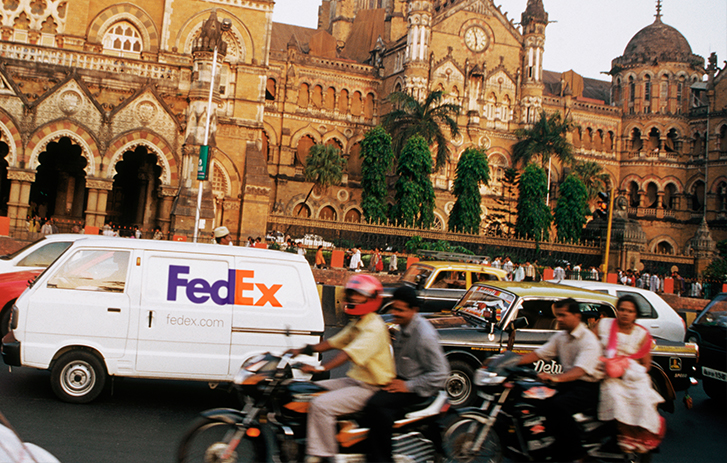
TRENDS & INSIGHTS / MARKET INTELLIGENCE
Executive summary
India is a vast market with many compelling attractions for European businesses, including an expanding economy, a young population and a growing middle class.
E-commerce – including cross-border e-commerce – continues to grow on the back of government initiatives and huge numbers of smartphone users.
Free trade negotiations with the EU and UK could result in further opportunities for SMBs focusing on India, including significant export gains in certain sectors.
It’s important for exporters to have a close understanding of India’s customs regulations – requirements may be more complicated than for some other export markets.
Uncovering India’s potential
India’s size, scope and market potential make a compelling case for the country to be of significant interest to European businesses. Not only is it the world’s largest democracy with a population close to 1.5 billion, it’s also the fifth-largest economy globally. And that economy is expected to grow rapidly – in fact it’s predicted to be the fastest growing major economy for the next two fiscal years (FY26 and FY27).1
India’s huge consumer market is bolstered by many positive factors. These include the country’s young population. With a median age of 28, India counts 65% of its citizens as being under 35.2 It also has a large, and expanding, middle class. Currently 31% of the population is in that category, but this is expected to rise to 38% by 2031 and 60% by 2047.3
The e-commerce market, meanwhile, is thriving. Its value was $123 billion in 2024, but that figure is set to surge to $300 billion by 2030 on the back of growing numbers of internet users and favourable market conditions.4
And it shouldn’t be forgotten that India is also a large production location, with the EU being India’s second-largest destination for exports.5 Over the last decade, trade in goods between the EU and India has increased by almost 90% and, with a possible free trade agreement (FTA) on the horizon, the potential for further increase in both imports and exports is considerable.
India in focus: demographic trends and market insights
1.43 billion
Size of India’s population6
$3.57 trillion
India’s GDP7
€65.1bn
Value of the EU’s imports from India8
€48.4bn
Value of the EU’s exports to India9
$2.58 trillion
Forecast for total consumer spending in India in 202510
345 million+
Number of digital buyers in India11
Opportunities for SMBs in India
India’s status as a key trading partner for the EU signals the strong market potential that SMBs across Europe could capitalise on. In fact, figures show that – in the UK – 11% of exporting SMBs are already exporting goods or services to India.12
In terms of specific opportunities, it could be worth looking at the major EU exports to India to see where valuable trade relationships are already established. These include machinery, electrical and electronic equipment, pharmaceutical products, and medical equipment.13 Healthcare is actually one of the sectors where India and the EU are key trading partners, with around a third of active pharmaceutical ingredients (APIs) sold in the EU coming from India and the EU accounting for almost a third of India's medical devices imports.14
It's also worth considering e-commerce. This rapidly expanding channel is another key opportunity for European SMBs. Government efforts to expand internet provision and digital literacy – led by its Digital India initiative – have helped to develop an e-commerce sector that saw a 19% increase in sales in 2024.15
What’s more, cross-border e-commerce sales are expected to grow too. They were worth $8 billion in 2023, are expected to have hit $9.6 billion in 2024, and are forecast to grow by a further 29% in 2025 to $12.4 billion.16 Clothing, electronics, consumer health and beauty are among the most popular categories for online shopping.17
Businesses in Europe should also keep one eye on the future too. India is currently in negotiations with the EU (and the UK, separately) on a potential free trade agreement. If a deal is reached, it is expected to have a positive impact for many small businesses in Europe.
According to a trade sustainability impact assessment produced by the European Commission to support the FTA negotiations, an agreement is expected to see exports from several of the main SMB-intensive business sectors – such as electronics, machinery, rubber, and plastics – see significant gains.18
Switzerland has recently agreed its own FTA with India, and the 2024 deal is already prompting SMBs there to view India as a potential new export market. According to Switzerland Global Enterprise, of those SMBs that want to enter new markets in the first six months of 2025, many are increasingly focusing on India with the country now viewed as the most important new market in the world.19
Exporting to India: need to know
Every country has its own set of import regulations and customs procedures, and while India’s may appear to be more complicated than others – with additional paperwork requirements that you may not be used to – it’s worth taking the time to understand the rules clearly to avoid delays while shipping and to help capitalise on the potential of the market.
When you ship goods into India, they will go through one of two customs processes – express clearance or formal clearance. As a rough guide, express clearance – also known as courier mode – is for low-to-medium-value goods in packages weighing up to 70kg. Formal clearance, which is also known as freight mode, is for high-value shipments or lower value ones that contain regulated goods. But it’s important to check the criteria for each closely to see which one applies to your shipment, as this will enable you to prepare the correct documentation in advance.
And getting that documentation right is critical. As well as the commercial invoice and air waybill, when shipping into India you will also need to supply the receiver’s Know Your Customer (KYC) documentation in advance. This confirms the receiver’s identity and address, and is necessary for both business and private customer shipments. Receivers will need to submit their KYC proof to the carrier of the shipment.
Be aware that, depending on your shipment, you may also need to provide additional paperwork. Some goods require import licenses and/or may need to be registered, while certain goods will also need to comply with various regulations covering their import into India.
And as a free trade deal with the EU has yet to be reached, tariffs will also be a factor when considering your strategy. India’s tariffs are 17% on a simple average basis and 12% on a trade-weighted average, which is quite high compared to some other countries.20 China, for instance, has average tariff rates of 7.5% and 3%, respectively21, and the U.S. has average rates of 3.3% and 2.2%.22
For more information, you can read our guide on shipping to India. However, its essential to thoroughly check the rules and regulations that apply to your shipment. Some useful links to explore include the Ministry of Commerce and Industry, where you can find a list of prohibited items, while information on customs compliance procedures and requirements for imports and exports can be found at the India Customs Compliance Information Portal.
Three more things to consider
Understand the consumers
India is a vast country, with many different cultures and a huge variance in income levels and consumer attitudes across the population. So, it’s essential to research the market carefully understand who you are targeting, where they live and how best to appeal to them, in everything from cost to preferred sales channels.
Whatever you do, it’s likely that mobile will be a key part of your strategy. India is the world’s second-largest smartphone market after China, with estimates putting user numbers at more than a billion and a penetration rate at over 70%.23 Research also suggests that Indian consumers use mobile devices for just under two-thirds of all online transactions, so optimising for mobile – such as by making sure pages adapt to different screen sizes, load quickly and are easy to read , as well as simplifying the checkout process and catering to mobile-friendly payment options such as digital wallets – is a smart move.24
It may also be worth paying attention to the premiumisation trend among Indian consumers. The premium segment is reportedly growing at twice the pace of price rises, propelled by urbanisation, higher incomes and a growing middle class, with e-commerce now expanding the potential market further into tier 2 and 3 cities.25
Recognise the import potential
India is not just a market with great consumer potential. It’s also a major production country with export strengths in several industries – including textiles and apparel, jewellery, metals and machinery.26 But perhaps more intriguing are its future possibilities, as many companies pursue moves to broaden their sources of supply.
India is expected to triple its manufacturing base by 2031, for instance, as it benefits from nearshoring and friendshoring policies (moving sourcing closer to home or to countries that are political or economic allies) among businesses keen to diversify their supply chains and insulate them from potential disruption.27
The government has also been implementing a ‘Make in India’ strategy, designed to establish the country as a key global manufacturing centre through measures that include improvements in the domestic supply chain and incentivising investments in advanced production facilities.28 These developments mean that, even if India isn’t already on your production radar, it could be soon.
Plan logistics carefully
India’s infrastructure can throw up challenges in parts of the country, with issues including poor road conditions, skilled labour shortages and a lack of available land for warehousing needs.29 These can all cause delays and add additional costs, so it’s important to be aware of them when plotting moves into India so you can find practical solutions.
The specific situations you face will likely depend in part on the sales model you have – e.g. direct-to-consumer, via an agent or by selling through a distributor – but whatever your strategy it’s important to understand the particular challenges you could face.
Consider the locations you ship to carefully – it may be that you decide to focus on the more well-trodden paths and concentrate on major urban centres, which could help you to avoid some unknowns around rural landscapes and less well-developed areas.
It’s also important to understand (and plan for) the costs and timings involved. The more realistic you are on the latter, the less likely you are to disappoint your customers, and bear in mind that traffic congestion can be an issue in India. Incorrect addresses can also cause major hold-ups in delivery, so ensure all details are correct before sending your shipment.
One way to address some of the logistics challenges is to partner with a reliable delivery partner that can enable you to maximise the opportunity and deliver on your promises to customers. As well as helping you to navigate customs requirements – and having the experience and network to plan for other logistical challenges that may arise – the right partner should also be able to provide monitoring and tracking services that allow you and your customers to stay up to date with the progress of deliveries, reducing potential frustration and enhancing peace of mind.
Trading with India: your next steps to take
If you’re looking to tap into the potential of the Indian market, it’s essential to do your research carefully to find where the best opportunities may lie. Costs, demographics, location, and consumer preferences will all play a part, and remember to look into (and plan for) potential logistics challenges and the specific customs requirements for your products. For more information on crossing customs borders compliantly, you can check out our Customs Clearance pages alongside our specific guide on shipping to India.
Disclaimer: The information provided on this page does not constitute legal, tax, finance, accounting, or trade advice, but is designed to provide general information relating to business and commerce. The FedEx Small Business Hub content, information, and services are not a substitute for obtaining the advice of a competent professional, for example (but not limited to) a licensed attorney, law firm, accountant, or financial adviser.
1 India: World’s Fastest-Growing Major Economy | Ministry of Information & Broadcasting, 2025
2 Navigating India's Skill Landscape | Ministry of Information & Broadcasting, 2024
3 The Rise of India's Middle Class: A Force to Reckon With | PRICE, 2023
4 Market size of e-commerce industry across India from 2014 to 2024, with forecasts until 2030 | Statista, 2024
5 India | European Commission
6 Population, total – India | World Bank
7 GDP (current US$) – India | World Bank
8 India | European Commission
9 India | European Commission
10 Consumption Indicators – India | Statista, 2024
11 Number of digital buyers in India from 2010 to 2023, with estimates until 2027 | Statista, 2024
12 Longitudinal Small Business Survey: SME Employers (businesses with 1 to 249 employees) – UK, 2023 | GOV.UK, 2024
13 European Union Exports to India | Trading Economics, 2025
14 EU-India cooperation on health | European Parliament Research Service, 2023
15 Market size of e-commerce industry across India from 2014 to 2024, with forecasts until 2030 | Statista, 2024
16 Value of online retail sales across borders from India in 2023, with estimates until 2025 | Statista, 2024
17 B2C e-commerce in India - statistics & facts | Statista, 2024
18 EU India SIA_Final Report | CIRCABC, 2024
19 Exports by Swiss SMEs in 2025: Cautious Optimism Despite Global Uncertainties | Switzerland Global Enterprise, 2025
20 Tariff profiles: India | WTO
21 Tariff profiles: China | WTO
22 Tariff profiles: United States of America | WTO
23 Number of smartphone users in India in 2010 to 2023, with estimates until 2040 | Statista, 2023
24 Payment methods in India | PPRO
25 Luxury unleashed: India’s growing appetite for premium | Campaign India, 2024
26 Look into India Top 10 Exports 2025: Trends and Opportunities | Eximpedia, 2024
27 Charting Strategies for a Multipolar World | Morgan Stanley, 2023
28 A decade of Make in India | JLL, 2024
29 Road Infrastructure and Skilled Workforce Shortages: Key Challenges for India's Logistics Industry | Outlook Planet, 2024



